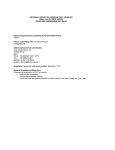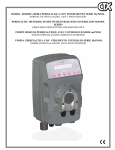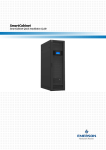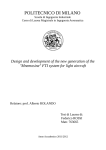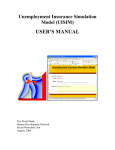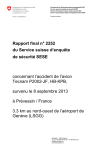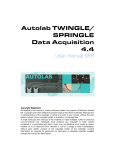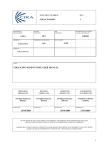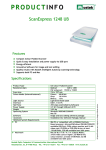Download CIRA-UM-04-008 CIRA PWT USER MANUAL
Transcript
CIRA-UM-04-008 CIRA PWT USER MANUAL DEPARTMENT DIPARTIMENTO PROJECT PROGETTO LMSS NO. OF PAGES N. PAGINE JOB COMMESSA PWT ARCHIVE-POSITION ARCHIVIO-POSIZIONE *** 20 DISTRIBUTION STATEMENT NATURA DOCUMENTO 30.9024.0000 FILE NAME PWT UM.DOC SOFTWARE MICROSOFT WORD 2000 TITLE TITOLO CIRA PWT USER MANUAL PREPARED PREPARATO REVIEWED VERIFICATO APPROVED APPROVATO AUTHORIZED AUTORIZZATO C. Purpura F. De Filippis S. Caristia S. Caristia EDITOR E. Trifoni A. Del Vecchio DATE/DATA E. Graps A. Panico DATE/DATA DATE/DATA DATE/DATA BY THE TERMS OF THE LAW IN FORCE ON COPYRIGHT, THE REPRODUCTION, DISTRIBUTION OR USE OF THIS DOCUMENT WITHOUT SPECIFIC WRITTEN AUTHORIZATION IS STRICTLY FORBIDDEN A NORMA DELLE VIGENTI LEGGI SUI DIRITTI DI AUTORE QUESTO DOCUMENTO E' DI PROPRIETA' CIRA E NON POTRA' ESSERE UTILIZZATO, RIPRODOTTO O COMUNICATO A TERZI SENZA AUTORIZZAZIONE I CIRA-UM-04-008 CIRA PWT USER MANUAL AUTHORS : C. PURPURA TITLE : CIRA PWT USER MANUAL ABSTRACT : The present document describes the characteristics and the procedures of the new CIRA Plasma Wind Tunnel SCIROCCO. The PWT performance and the main dimension are described. The PWT auxiliary systems have been described with their mechanical interfaces. The time schedule requirements and the support requirement have been also outlined in order to give a guideline to PWT test organization and facility reservation. Furthermore the CIRA location and nearest lodging options have been presented. KEYWORDS : Plasma Wind Tunnel, Arc-jet , Hypersonic, Experimental, Instrumentation. According to the italian law n. 15 of January 4/1968 and, successively revised on July 6/1997, the undersigning certifies the present copy to be true to the original which remains at your disposal for inspection. Place : Capua (CE) - ITALY Company stamp : CIRA S.c.p.A. Date : Signature : First name : Last name : Position : ____________________________ ____________________________ ____________________________ ____________________________ ____________________________ II CIRA-UM-04-008 CIRA PWT USER MANUAL REVISION LIST LISTA DELLE REVISIONI REV. 0 DESCRIPTION First Issue DATE EDITOR 30.11.2003 C. Purpura III CIRA-UM-04-008 CIRA PWT USER MANUAL SUMMARY 1.0-INTRODUCTION .................................................................................................. 2 2.0-LIST OF ACRONYMS .......................................................................................... 2 3.0-FACILITY DESCRIPTION .................................................................................... 2 4.0-TUNNEL OPERATION ......................................................................................... 4 4.1-SCIROCCO PLASMAWIND TUNNEL: AERO-THERMOFLUIDODYNAMIC PERFORMANCES .. 4 5.0-TEST CHAMBER DETAILS ................................................................................. 6 6.0-ARC HEATER AND NOZZLE SYSTEMS ............................................................ 7 7.0-TEST EQUIPMENTS ............................................................................................ 9 7.1-MODEL SUPPORT SYSTEM (MSS)............................................................................. 9 7.2-CALIBRATION PROBE ARMS (CPA) ....................................................................... 10 8-AUTOMATION SYSTEM ....................................................................................... 10 9-ISTRUMENTATION ............................................................................................... 12 10-TEST GENERAL ARRANGEMENT .................................................................... 14 11-PERSONNEL SAFETY ISSUES ......................................................................... 15 12-CIRA SITE LOGISTIC ......................................................................................... 15 13-PWT TEST REQUEST PROCEDURE................................................................. 15 14-CONTACT POINT ............................................................................................... 16 15-REFERENCES .................................................................................................... 16 Page 1 of 23 CIRA-UM-04-008 CIRA PWT USER MANUAL 1.0-INTRODUCTION CIRA, the Italian Aerospace Research Centre, has recently built a 70 MW Plasma Wind Tunnel, arc-jet kind named SCIROCCO. The facility primary mission is to simulate the thermo-fluid-dynamic conditions on Thermal Protection System of space vehicles reentering the earth atmosphere, on models in scale 1:1. The CIRA Plasma Wind Tunnel (PWT) SCIROCCO is a high enthalpy hypersonic wind tunnel at the boundaries of state of art technology. This document describes the wind tunnel technical characteristics and performances, its instrumentation and the typical operative procedures. The facility is located in Capua (CE), Italy about 50 km north of Naples. The Plasma Wind Tunnel is part of a grand new complex which includes ground testing facilities and dedicated service utilities making up the Italian Aerospace Research Centre. The picture in Fig.1 shows an aerial view of the facility. GWS Report Generation Workstation HBDS High Band Data System HLAS High Level Automation System hmax Maximum Enthalpy hmin Minimum Enthalpy I Current Imax Maximum Current LMSS Space Instruments and Facilities laboratory LBDS Low Band Data System LCU Local Control Unit MCC Motor Control Center mmax Maximum Flowrate MSDS Model safety and Failure Mode Analysis MSS Model Support System OWS Operator Workstation pmin Minimum Pressure Pmax Maximum Power PWT Plasma Wind Tunnel RWS Requester WorkStation RTS Real Time Simulator SCAS Supervisory Controls and Automation System SDM Simplified Dynamic model SDESIM Development System for Simulator SMSA Safety Management Sub-Assembly Test Article TA TEWB Test Engineer’s Work Bench TAL Test Automation Language TC Test Chamber UPS Uninterruptable Power Supply V Voltage 3.0-FACILITY DESCRIPTION Fig. 1: Plasma Wind Tunnel aerial view 2.0-LIST OF ACRONYMS AC CPA DAS DDM DeNOx ENEL ESA ESP FEE FS Alternate Current Calibration Probe Arms Data Acquisition System Detailed Dynamc Model Nitrogen Oxides abatement National Electrical Energy Agency European Space Agency Pressure Scanner Measurement System Front End Equipment File Server The PWT facility lay-out is shown in Fig. 2.The heart of the facility is the segmented constricted Arc Heater, a column with a maximum length of 5.5 m and a bore diameter of 0.11 m. At the ends of this column there are the electrodes (cathode and anode) which generates the electrical arc. The Power Supply gives the voltage at the electrodes for the generation of the discharge; it is able to support direct current up to 9000 A and a total power up to 70 MW. A Compressed Air Supply distributes dry air to the various segments of the arc heater column. It is able to supply a flow range from 0,1 to 3,5 kg/s with a total pressure range from 1 to 17 bar. The Arc Page 2 of 23 CIRA-UM-04-008 CIRA PWT USER MANUAL Heater column is cooled by circulation of demineralised water. CUSTOMER WORKSHOP CUSTOMER WORKSHOP Argon System DeNOx Diffuser Cooling Power Supply TEST HALL AREA Test Building PWT ENTRANCE Heat Exchanger Vacuum System Fig.2: Facility schema The compressed air injected into the arc heater is heated up to 10000 K of temperature and flows through a convergent-divergent Conical Nozzle increasing the velocity in the Mach range 6-12. The jet exiting from the nozzle is confined into a Test Chamber where interacts with the test article. Then, it is collected in a long Diffuser (50 m) and cooled by an Heat Exchanger. The test article is installed on the Model Support System (MSS). The last sub-system of the Scirocco facility is the Vacuum System. It generates the vacuum conditions required by each test. The system consists of ejectors that make use of high pressure water steam as motor fluid (30 bar and 250°C).Before ejection into the atmosphere, the process fluid is scrubbed by chemicals in a subsystem called DeNOx System to eliminate the Nitrogen Oxides. The Test Chamber is located into an area Experimental Hall as shown in Fig.3. Fig 3: Experimental Hall floor The facility can use various Conical Nozzles for different test conditions. These interchangeable components are stored inside a parking area into the Experimental Hall. A Hoist System for handling of heavy bodies, as nozzles sections, models, supports etc. is fixed to the building ceiling. The main building has the function to host the operating team, the users offices and the facility control system room. The control room is located on the first floor where the Experimental Hall can be viewed through a large window. The control room equipment (see fig. 4) includes the video camera monitors, the video recording facility, operator console(s) and the engineering and data acquisition systems that provide complete information about the test and model conditions. Page 3 of 23 CIRA-UM-04-008 CIRA PWT USER MANUAL 4.1-SCIROCCO PLASMA WIND TUNNEL: aero-thermodynamic performances The Scirocco PWT facility has been realized to simulate pressure and temperature to which earth atmosphere re-entering space vehicles are exposed. The requirements for Scirocco have been specified by ESA in terms of pressure and temperature on the test model stagnation point. Based on the requirements, two nominal sample configurations are defined: TEST HALL AREA CONTROL ROOM CUSTOMER OFFICE Fig. 4: Control room floor A dedicated large area is also available for working on the Arc Heater components (Maintenance Hall) . Three workshop room are located near the Maintenance Hall for Instrumentation and Model preparation. Before a specific test, the selected Conical Nozzle configuration is installed between the Arc Heater and Test Chamber. Then the model is directly installed inside the Test Chamber on the MSS by means of the dedicated interface. • Nose configuration: hemisphere with radius of 300 or 240 mm and overall dimensions size of 600x600x600 mm. • Leading edge configuration: twodimensional hemicylinder with variable radius and curvature radius at stagnation point of 100 mm. Overall dimensions size of 600x600x600 mm. The required stagnation point pressure and temperature are relative to three possible reentry trajectories named: nominal, extreme and safety. They respectively represent a normal, a extreme, and an emergency trajectory re-entry. In the following tables there is a synthesis of required performances to the facility for Nose Configuration and Leading edge Configuration. 4.0-TUNNEL OPERATION The hypersonic plasma-jet usable for the PWT test achieves Mach numbers depending on the Conical Nozzle exit diameter. Four nozzle configurations are available corresponding to Mach flow values of about 5.1, 6.2, 8.3, 11.5 respectively. Some deviations from the mentioned values can be observed during a test due to the variations of the air chemical composition of the exiting jet. The Reynolds number per meter is shown to vary from 10.000 to 160.000, while the flow velocity varies from 2000 to 6000 m/s, independent from the used nozzle, as predicted from the hypersonic theory. REQUIREMENTS: nose configuration. Press. Stagn. point Temp. Stagn. point Test time Nominal trajectory Extreme trajectory Safety trajectory 10÷75 mbar 10÷75 mbar 75÷175 mbar 1300÷1600 ºC 1600÷1700 ºC 1450÷1700 ºC 25 minutes 25 minutes 5 minutes Page 4 of 23 CIRA-UM-04-008 CIRA PWT USER MANUAL Extreme trajectory Safety trajectory 5÷25 mbar 5÷25 mbar 15÷100 mbar 1000÷1250 ºC 1200÷1400 ºC 1300÷1600 ºC 25 minutes 25 minutes 5 minutes The above requirements have been translated in terms of pressure and heat flux at stagnation point for both Nose and Leading edge configuration. This conversion has been carried out under the hypothesis of a model in Test Chamber of fully catalytic material, with thermal conductivity of 7 W/m-K, surface emissivity of 0.85 and model radius of 300 mm (nose) and of 100 mm (leading edge). The transformed requirements are reported in the following table. REQUIREMENTS IN TERMS OF HEAT FLUX NOSE Heat flux Nominal trajectory Extreme trajectory Safety trajectory 428÷ 846 kW/m2 846÷1035 kW/m2 612÷1035 kW/m2 230÷380 kW/m2 300÷600 kW/m2 LEADING EDGE 125÷260 Heat Flux kW/m2 The facility has been designed to satisfy the ESA requirements; the present design returns a greater capability as shown in the following. The Arc Heater has the capability to provide to the Conical Nozzle air with a total pressure and a total enthalpy contained into the map reported in Fig. 5, that represents the “Performance Map”. Between the column Arc Heater and the Nozzle a Plenum Chamber is located, where it is possible to inject compressed air at ambient temperature, in order to reduce the total gas enthalpy. By this way it is possible to reduce the minimum gas total enthalpy up to 2.5 MJ/kg; in fact, the minimum enthalpy level that the Arc Heater is able to produce is 10 MJ/kg. EXPLORED REGION PREDICTED PERFORMANCES 40 2 Press. Stagn. point Temp. Stagn. point Test time Nominal trajectory The curves in this figure have been obtained considering the operating and technological limits of the facility: 1. Minimum air pressure of 1 bar for arc stability 2. Maximum allowable total gas enthalpy of 45 MJ/kg 3. Maximum flow rate from Process Air System of 3.5 kg/s 4. Minimum allowable total gas enthalpy of 2.5 MJ/kg Total Enthalpy, kW/m REQUIREMENTS: leading edge 30 20 10 0 0 1 2 3 4 5 6 7 8 9 10 11 12 13 14 15 16 Total Pressure, bar Fig. 5: Theoretical Performance Map (Total Pressure and Total enthalpy at the inlet of the convergent nozzle). From the “Performance Map” an equivalent diagram of facility capabilities has been obtained in terms of pressure and heat flux at stagnation point as function of the model size and the nozzle configuration. The facility can work with four different Conical Nozzle configurations, providing exit nozzle diameters respectively of 900 mm, 1150 mm, 1350 mm and 1950 mm. However, the nozzle throat is always the same with a diameter of 75 mm. For each configuration an effective exit nozzle diameter has been calculated taking into account the boundary layer thickness. Page 5 of 23 CIRA-UM-04-008 CIRA PWT USER MANUAL 900 1150 1350 1950 900 1050 1200 1500 144 196 256 400 The requirement for the hemispheric model of “Nose configuration” must have two different sizes with radius of 300 mm and 240 mm. The 900 mm exit diameter configuration cannot operate in conjunction with the model radius of 300, because the flow blockage around the model is foreseen. The following table summarizes the allowable configurations nozzle/model: Nozzle exit Area diameter ratio A/A• mm 144 900 196 1150 196 1150 196 1150 256 1350 256 1350 256 1350 400 1950 400 1950 400 1950 Configur. Nose Nose Nose Lead. edge Nose Nose Lead. edge Nose Nose Lead. edge Model radius mm 240 240 300 100 240 300 100 240 300 100 Fig. 6 represents the design maps of Stagnation point Pressure vs. Heat Flux of Scirocco PWT facility. EXPLORED REGION PREDICTED PERFORMANCES 1400 2 1200 Stagnation Heat-Flux, kW/m PROCESS REQUIREMENTS min max Air mass flow (kg/sec) 0,10 3,5 Air enthalpy content (MJ/kg) 2,50 45 Air operative pressure (mbar) 0,01 2,9 Exit Effective exit Area ratio diameter diameter A/A• mm mm 1000 800 600 400 200 0 1 10 100 1000 Stagnation Pressure, mbar Fig. 6: Performance map of Scirocco in terms of Pressure and Heat Flux at Stagnation Point on the model. The facility calibration is in progress. Actual results indicate coherence between experiments and predictions. 5.0-TEST CHAMBER DETAILS The Test Chamber (fig. 7) is a cylindrical vessel where the model to be tested is placed together with the relevant moving system (Model Support System). In the Test Chamber the model is impacted by the plasma flow coming from the Conical Nozzle, reaching the temperature and pressure conditions able to simulate the thermo-fluidynamic conditions acting on the protection shield of space vehicles during the atmosphere re-entry. The exit of the Test Chamber is connected through a mating flange to the “Pick-Up” of the Diffuser. The system has been designed in agreement with the following process requirements. TEST CHAMBER CHARACTERISTICS Shape Cylindrical Vertical Overall Size height inner diameter 9217 mm 5170 mm Material Steel Fe 510 The list of the most important equipment is hereinafter reported: Page 6 of 23 CIRA-UM-04-008 CIRA PWT USER MANUAL 1. Openings to allow access for personnel to enter the model, and for maintenance. 2. Windows to allow the plasma flow monitoring. 3. Retractable floor (two sections). 4. System to inject process air (bleed air system). 5. Air flow system. In the Test Chamber some systems are foreseen to allow the correct model positioning in the plasma flow (MSS), to measure the plasma characteristics (Calibration Probes) and to facilitate the maintenance operations on the Model (Retractable Floor). During the PWT operative phase the plasma flow, after having impacted the model, is driven toward the Diffuser “pick up” section. In the case of particular test conditions, it is foreseen the possibility to inject in the Test Chamber a small process air stream (through the “bleed air system”) in order to increase the static pressure in the test chamber and facilitate the flow driving in the pick up section of the Diffuser, in order to have a less severe Vacuum System operations. After each test, before allowing personnel access, re-pressurization, air washing operations and internal air characterisation are performed. The system air washing phase starts with cold dry process air, that continues to be supplied to the Arc Heater after the end of the test, and continues with atmospheric air that is sucked in by the fan. After few minutes from the beginning of the air washing phase, a fan is activated. A small mass flow of internal Test Chamber air is sent to an analyser to measure the content of O2,O3 and H; only when the level of the monitored gases is under the prescribed limits, the managing LCU2 ends the washing operation and allows the personnel access in the system. Fig. 7: Test Chamber 6.0-ARC HEATER SYSTEMS AND NOZZLE The arc heater is located in the Test Hall between the Compressed Air System and the Conical Nozzle. The arc heater is shown in fig. 8 through 10, and it is the generator of high temperature air (Plasma) necessary to simulate aerothermal flight condition of re-entry vehicles. The increase of temperature (10000 K) of the incoming process air takes place through the transformation of electric energy into thermal and kinetic energy) by means of an electric arc discharge between the electrodes. The gas, after being heated in the arc heater, is accelerated through the nozzle where the gas thermal energy is converted in kinetic energy. The arc heater has been designed in according to the following process data: Air pressure (Bar) Air mass flow rate (Kg/sec) Plasma enthalpy -(MJ/kg) Electric power -(MW) Direct current (Ampere) Voltage (Volt) MIN. MAX. 1,0 0,1 2,5 1,0 1000,0 1000,0 16,7 3,5 45,0 70,0 9000,0 30000,0 Page 7 of 23 CIRA-UM-04-008 CIRA PWT USER MANUAL coils, helps to position the arc on the electrode surface rapidly, and thanks to an electromagnetic mechanism, the interaction point between the electrode surface and the arc foot moves continuously minimising copper erosion and extending electrode lifetime. 3) Plenum section Fig.8: Arc Heater components Fig.9: Photographs and design draws of the Arc Heater The plenum chamber (fig. 11) constitutes the connection piece between the arc heater and the conical nozzle. The plenum function is to reduce the process air total enthalpy through cold air injection. Fig. 11: Plenum chamber and nozzle throat The following instrumentation is foreseen for monitoring and controlling the arc heater operation: • Current measurement on each power cable connected to the arc electrode rings; • Measurement of the voltage fluctuations generated between the anode and the cathode main power supply cables; • Voltage measurement among some arc heater column rings; • Plenum chamber pressure measurement; Fig. 10: Typical segment pack It is necessary to point out that the ignition of the arc heater is with the injection of argon only. Moreover, the combination of argon (air) gas injection and magnetic rotational force, generated by the current flow into the magnetic Aim of the Conical Nozzle System is to expand the plasma flow coming from Arc Heater for increasing its speed and simulate into PWT facility the requested thermofluidodynamic conditions. Four conical nozzles are available, all of them have the same throat and seven different Page 8 of 23 CIRA-UM-04-008 CIRA PWT USER MANUAL expansion sections are connected in such a way to return the required nozzle. This system has been designed in agreement with the process requirements at the component battery limits: PROCESS REQUIREMENTS min max Air mass flow (kg/sec) 0,1 3,5 Enthalpy (MJ/kg) 2,5 45,0 air content inlet Air pressure (bar) Air pressure (mbar) inlet outlet 1,0 0.01 16,7 2.9 Air speed (m/s) inlet outlet 120 2000 350 7000 The combination of the operative conditions as above reported, permits to obtain on the test model surface the required conditions in terms of Heat Flux (from 125 to 1035 KW/m2) and Stagnation Pressure (from 5 to 175 mbar) On the device, instruments for monitoring are installed. Measurement of plasma pressure corresponding to nozzle exit has been foreseen. Fig. 12: Conical nozzle mounted into Test Chamber (1150 mm exit diameter configuration). 7.0-TEST EQUIPMENTS 7.1-MODEL (MSS) SUPPORT SYSTEM The model to test is interfaced to an automated cooled arm (fig. 13), the Model Support System (MSS). Fig. 13: Model Support System The model mechanical interface with MSS, generally realized by the customer, is through a plane flange φ 304 mm with eight M12 plane holes at φ 240 mm; the corresponding flange on MSS side (fig. 14) is provided of two reference pin holes for clocking purpose. Fig. 14: MSS Interface flange Maximum overall model weight (including instrumentations and cables) is 1650 N, center of gravity lying on MSS flange center line. Page 9 of 23 CIRA-UM-04-008 CIRA PWT USER MANUAL Maximum overall model length in plasma direction, i.e. between the stagnation point and the MSS interface plane, is 1010 mm. Before the test, the model is located under the Test Chamber floor level. The MSS flange center line is 1650 mm far from plasma center line. During the test, the model is injected vertically in the plasma flow; once achieved the plasma center line, the model can be moved horizontally up to 750 mm downstream, respect to the plasma flow, and pitched ± 20° around a center of curvature 1010 mm upstream MSS interface plane. During the motion, the model is subject to the following maximum kinematic conditions 7.2-CALIBRATION (CPA) PROBE ARMS In the Test Chamber there are two calibration arm (Calibration Probes Arms). Also these arms are cooled using pressurised demineralized water. Their function is to support and locate measurement instruments into the plasma in order to measure its characteristics in several positions. The arms of the Calibration Probes can rotate around an axis, parallel to the plasma flow axis, and can be located in such a way that the center-line of the installed instrumentation can coincide with the plasma flow axis. The motion is actuated by electrical motors. 8-AUTOMATION SYSTEM Vertical Horizontal Angular Speed Acceleration ± 0.6 m/s ± 0.2 m/s ± 4 °/s ± 3.0 m/s2 ± 1.9 m/s2 ± 40 °/s2 During the test, the expected aerodynamic loads on the model must not exceed the following values: Drag Lift Lateral 5330 N ± 800 N ± 533 N A maximum of 160 pressure channels and 100 temperature channels for the model are available at MSS interface. A cooling system for the model is available at MSS interface, providing a maximum demi water flow rate of 18 m3/h at a maximum pressure inlet of 38 barg and at a minimum pressure outlet of 8 barg; the minimum pressure outlet can be increased up to 15 barg . The PWT Control and Automation System is realised in different levels, and the Data Acquisition System is integrated in it assuring the experimental data sampling and storage (fig. 15). The facility instruments are divided into two categories: the control instruments and the process instruments. The control instruments are those installed in the facility, used to verify the proper operation of each subsystem. The process instruments are those whose acquired data are used as experimental test results. An independent supervisor system verifies that the all parameters of the facility operating conditions are within their safety ranges and each subsystem is properly operating. HLAS SCAS-SIM TEWB HLAS-GWS PRINT SERVER AIS Mngm. Link HLAS-RWS HLAS-OWS PRINT SERVER SCAS SDESIM-WS HLAS-FS PWT Process Control Link ESP DAS HBDS LBDS LCU 1 LCU 3 LCU 2 LCU 5 LCU 4 LCU 7 LCU 6 LCU-EWS LCU-OWS An electrical system for the model is available at MSS interface, consisting in a 500 W – 220 VAC cable with 3 conductors (phase, neutral, ground) and a ground cable (S = 16 mm2). PRESSURE TRANSD. PRESSURE TRANSD. THERMOCOUPLES THERMO CAMERAS CALORIMETERS POSITIONER VIDEO CAMERAS SPECTRORAD. (opt.) SPECTROSCOPE (opt.) CONVENTIONAL TEST INSTR. SCHLIEREN SYS. (opt.) VIRTUAL TEST INSTR. LCU PLASMA HEAT EX. PYROMETER CONICAL NOZZLE SAFETY S/S VACUUM & STEAM DENOX & OSMOSIS MODEL SUPPORT TEST CHAMBER POWER SUPPLY DIFFUSER ARC HEATER COOLING SYS. COMPRESSED AIR ARGON SYSTEM ELECTRICAL SYS. SAFETY FIELD INSTRUM. PWT SUBSYSTEM Fig. 15: Automation System scheme Page 10 of 23 CIRA-UM-04-008 CIRA PWT USER MANUAL The building blocks of the PWT Automation and Instrumentation Systems are: − High level automation system The High-Level Automation System encompasses all the computing and display resources needed to perform the control of the PWT at level 3, i.e. test conduction, control of the overall facility, exploiting data acquired by Test Instrumentation (via DAS), to fix operating parameters of the Control System (LCU). - File Server (FS), which acts as a “general repository” of all the HLAS data, including: • data prepared by the Test Engineers using the TEWB • data acquired by the LBDS - Test Engineer’s WorkBench (TEWB), a SW development environment to allow the preparation of the Automated Test Procedures (written in Test Automation Language, TAL) and of the I/O Tables for a specific test session. - HLAS Operator Workstation (OWS), which is the main MMI of the system and allows both to examine in real-time a selected subset of the acquired data and to issue automation control commands for the test conduction. - HLAS Requester Workstation (RWS), allowing to examine in real-time a selected subset of the acquired data but without the possibility to issue automation control commands (customer W.S.). • Simplified (SDM) • Detailed (DDM) • Real-Time Simulator (RTS) Dynamic Dynamic Model Model The first 2 SW packages (SDM and DDM) can be used for the definition of the test parameters to be used in next test campaigns, while the RTS is aimed to allow the functional validation of Automated Test Procedures before their actual execution on the SCAS. The HLAS includes the following computers/workstations equipments: - Supervisory Control and Automation System (SCAS), on which are executed the Automated Test Procedures. SW Development System for Simulator (SDESIM), on which the following main SW packages can be executed: − SCAS Simulator (SCAS-SIM), interfaced to the RTS for the execution of real-time test simulations. − Peripherals and LAN items Data Acquisition System (DAS) The Data Acquisition System encompasses all the HW and SW equipment needed to acquire real-time measurement data from the Test Instrumentation and field devices, store them for further post-processing and (in case of LBDS) transmit them in real-time to HLAS to allow the control of the PWT at level 3. The HLAS can be further divided in: − Low-Bandwidth Data Acquisition System − High-Bandwidth Data Acquisition System Low-bandwidth data acquisition system The LBDS system shall be composed by two main items connected via TCP/IP LAN: - HLAS Report Generation Workstation (GWS), dedicated to the post-processing of the data acquired in real-time during a test execution session. Page 11 of 23 CIRA-UM-04-008 CIRA PWT USER MANUAL 1. LBDS Workstation (LBDS-WS), in charge to perform the following functions: - interface with the Operator for standalone operations Computer for Commands/Events acquisition/sending. The HBDS computer is located in the Computer Room and the HBDS front-end is located in the Electronic Room. - interface with the File Server for I/O Configuration Tables loading and test data archiving 9-ISTRUMENTATION - interface with the Automation Computer for commands acquisition and events emission The Scirocco PWT facility is provided by an extended Test instrumentation supply in order to fully characterise - interface with the Automation Computer for parameters sending and acquisition - interface with the FEE for set-up and data acquisition - data calibration and transmission to Automation Computer - support to calibration tables preparation 2. LBDS Front-End Equipment (LBDSFEE), also called "Measurement FrontEnd", in charge to perform the following functions: interface with the Test Instrumentation for analog signals acquisition, filtering and A/D conversion - handling of spare I/O channels - interface with the WS for set-up and data transmission - support to sensors and channel calibration operations Moreover, the LBDS supply includes a IEEE488 controlled instrument to support sensors and channels calibration operations. High-bandwidth data acquisition system The HBDS system is consisting of a Pentiumbased Personal Computer and a measurement front-end dedicated to acquire the input signals from the Facility devices. The HBDS computer is connected via a TCP/IP LAN to the File Server for I/O Configuration Tables loading and for HBDS data archiving, and to the Automation • • • the flow properties in Test Chamber, the thermodynamic properties on the model surface, the flow properties along the Test Leg in terms of temperature, pressure, heat-flux and chemical composition. CIRA test engineers are available for support and data interpretation. Nevertheless customers are free to operate, within their individual agreement with CIRA, their own instrumentation. To perform these measurements, real time (i.e. directly managed by the Data Acquisition System) and non-real time (i.e. fully independent measurement system) instruments are foreseen. There are also some instruments able to follow the “dynamic re-entry trajectory simulations” that Scirocco PWT would be able to realize. All the instruments positioned outside the Test Chamber, near the optical accesses, are mounted on remote controlled positioners, able to follow the model displacements along the flow axis and to focus the measurement region on the model surface. Two video cameras are available. They monitor the phenomena into Test Chamber during all the test phases. In the following a detailed functional and technical description of the various instruments is given: Page 12 of 23 CIRA-UM-04-008 CIRA PWT USER MANUAL Flow properties in Test Chamber instruments • Calorimetric probes Function: to measure the heat flux and pressure distribution of the of the plasma jet on the surface of an hemisphere (100 mm diameter). Tech. Gardon gauge calorimeters, Description: real-time mode acquisition, available ranges of 0÷500, 0÷1000 and 0÷3000 kW/m2. Interchangeable absolute pressure transducer on stagnation point, real time mode acquisition, available ranges of 0÷35, 0÷86, 0÷220 mbar. Interchangeable differential pressure scanner transducer, non-real time mode acquisition (ESP) with seven ports, available ranges of ±0÷25,±0÷70, and ±0÷350 mbar. • Pressure probes Function: to measure the pressure at the test model stagnation point and the pressure profile in the transversal flow direction Tech. Interchangeable absolute Description: pressure transducer, real time mode acquisition, available ranges of 0÷8.6, 0÷35, 0÷86, 0÷140 and 0÷220 mbar. • Spectroscopic system Function: to characterise the chemicalphysical properties of the flow (free-stream and shock-layer) Tech. Fully computer-controlled Description: system, non-real time acquisition, spectral range 190÷1200 nm wave-length, scan rate 45 nm/sec, CCD detector 2000x800 pixels. Thermodynamic properties on the model surface instruments • Pressure Scanner Measurement System (ESP) Function: to measure the distribution of the pressure on the model surface. Tech. Fully integrated system of Description: interchangeable differential pressure scanner transducers (ESP), non-real time mode acquisition, up to 200 measurement points, available ranges of ±0÷25,±0÷70, and ±0÷350 mbar., • Thermocouples Function: to measure the distribution of the temperature on the model surfaces. Tech. Set of thermocouples type B Description: (max 40) and K (max 60) for a maximum of 100 real time acquisition points, measurement range of 0÷1750 °C. • Pyrometers Function: to measure the temperature on the model surfaces. Tech. Spot measurement, two single Description: colour and two dual-wave instruments, real time acquisition, ranges of 400÷800, 600÷1000, 700÷1400 and 1000÷3000 ºC. • Thermograph systems Function: to quantitatively map the temperature distribution on the model surfaces. Tech. Two infrared scanners, noDescription: real time acquisition, spectral range of 8÷12 µm. Page 13 of 23 CIRA-UM-04-008 CIRA PWT USER MANUAL Flow properties along the Test Leg instruments • Static pressure measurement system Function: to measure the static pressure in various points of the test leg: 1. Plenum Chamber 2. Conical nozzle exit 3. Test Chamber 4. Diffuser Tech. Absolute pressure transducers, Description: real time acquisition: 1. Two transducers, range 0÷5.5 and 0÷22 bar 2. Two set of four transducers, range 0÷2 or 0÷10 mbar 3. Two set of four transducers, range 0÷2 or 0÷10 mbar 4. Sixteen transducers, 8 of range 0÷10 mbar and 8 of 0÷100 mbar 10-TEST GENERAL ARRANGEMENT The Scirocco PWT facility have been designed for a 3runs/day, 10runs/week, 250runs/year maximum test rate. The currently proven testing capability is 1run/day, 3runs/week on a 8 hour single shift, although 2runs/day rates have been also performed. Several on site activities are required to accomplish the tests on Customers Test Articles (TA): TA incoming inspection, TA instrumentation and mechanical interfacing on facility Model Support System (MSS), TA installation checks, test(s) execution, post test TA inspection. The two latter tasks are repeated, in case of a test campaign on a single TA. At the end of the testing activities the TA is dismounted and disconnected from the MSS. Two separate Model Preparation Area are available to allow Customer(s) activities on TA before and after the test (or test campaign) execution. The time required for the TA installation and checks, depends on its instrumetation complexity, meaning both sensors number and types. For a not instrumented model 4 hour is typical, while for a “heavely” instrumented model 3 days could be required. For the dismounting phase a mean time 1 day is typical. If required, pyrometers and/or thermocamera setting and pointing activities follow the TA installation phase. This task takes one additional work day (typ.). All the above tasks are performed by LMSS technicians, on the basis of Customer official Test Article installaltion data, with Customer on site Engineer assistance. The test execution is comprehensive of three phases: facililty start up (3 hour typ.), experiment conduction (can be repeated several times), facility shut down to safe condition (2 hour typ.). Customer on site Engineer is allowed to stay in the Control Room during the experiment conduction phase only (i.e. when the TA is injected into the plasma). After each test, data are collected and stored on the Data Acquisition System File Server. Then the most important (facility and model) rough data are printed for first evaluations. Official test report is issued within 30 working days after the test campaign conclusion. The format is both on paper and electronic format (CDROM). Three types of meeting are foreseen between LMSS and Customer’s Team, during the on site activities: a) a preparation meeting, b) one (or more) intermediate meeting, c) a test campaign conclusion meeting. Typically LMSS supplies the Customer all the necessary information to interface the Test Article to the facility (both mechanical and instrumental interface). On request the LMSS Team can size and supply the Model Holder and mount it on the Test Article. The time required depends on the test condition, TA structure and instrumentation. Typical time is 3 months. Page 14 of 23 CIRA-UM-04-008 CIRA PWT USER MANUAL The PWT is charged on the occupancy time plus number of tests basis, regardless the test condition(s) to be achieved. Model installation activities are considered within the occupancy time. All the engineering and/or service activities are quoted separately. 11-PERSONNEL SAFETY ISSUES Hazards Safety is first and foremost in the operation of PWT facility. The plasma arc heater is especially sensitive to proper and prudent safety procedures. The main risks are: lethal voltage, high-pressure gas, high-pressure water, high temperature, noise, mechanical hazards. Detailed indications are positioned in each critical area, nevertheless, PWT users are not allowed to operate any plant components. During pre-run briefing, the potential hazard is shown and discussed. PWT users are also informed about safety procedures before the test program start. This facility may pose serious hazards if strict adherence to all operating instructions and safety guidelines are not maintained. Failure to comply may result in serious injury or death. The facility must never be operated in presence of personnel in the test hall. Protective Equipments Hardhat, eyes and ears protection are available in the PWT Maintenance Hall. Other personal equipment needed for model workshop activities are not provided by CIRA. The PWT user has his own personal protection devices such as working gloves, shoes, to be used for model mounting and assembly in the model preparation area. Emergency Procedures The CIRA emergency procedure is illustrated to the PWT users. If required, all people present in the PWT area follow the instructions given by the CIRA Team Safety Responsible . 12-CIRA SITE LOGISTIC CIRA is located in Capua, a small city near Naples and Caserta, located at about 200 kilometers south of Rome and about 50 Kilometers North of Naples. Customers can arrange their trip to CIRA with a flight either to Rome (Fiumicino Airport) or to Naples (Capodichino Airport). 13-PWT TEST REQUEST PROCEDURE The hereinafter description will be focussed on technical aspects only. All the contractual activities, steps definitions and timings relevant to the request to test at PWTSCIROCCO facility will not be adressed. The TPS testing is divided in three main phases, typically: a) materials identification, testing and selection b) realization and test of a preliminary (dummy) model, rated 1:N respect the real object c) realization and test of the final model, rated 1:N respect the real object The Scirocco PWT can be used for testing in all the above three phases, although for phase a) a small arc-jet facility is more suitable. The typical path that drives to the test campaign completion, relevant to above phase b) or c), is as follows: During a meeting, Customer and PWT Engineers discuss about the test campaign objectives, the device to test, the test conditions and measurement requirements. Then PWT Engineers verify the feasibility of the test campaign, on the basis of the given test condition, Model geometry (shape and dimensions) and measurements requirements. Following technical discussion, Customer issues the agreed test matrix as well as the Test Article characteristics, instrumentation and data analysis requirements. Page 15 of 23 CIRA-UM-04-008 CIRA PWT USER MANUAL Preliminary Facility availability for the test campaign and relevant preliminary schedule are fixed at least 6 months before the beginning of tests. All the necessary information are sent to the Customer in order to properly interface the Test Article with PWT Model Support System: mechanical, instrumentation, cooling, electrical interfaces are reported in a dedicated document, as well as Test Article requirements in terms of maximum dimensions and weights. This is typically accomplished 6 months before the tests. The Customer shall issue the Test Article MSDS and a “Model Safety and Faiulure Mode Analysis” documents, the former required for the CIRA Personnel health and safety precautions, the latter to assure that the Model will not damage the Facility nor injury the CIRA Personnel. Furthermore the Model design documentation shall be submitted to CIRA for approval. The above is normally completed 3 months before the tests. As an option the Test Article realization, including holder and instrumentation, can be done by PWT team, if required. In this case the Customer shall supply all the necessary design documents and specifications. The materials can be selected and provided by Customer or by CIRA, the latter case on the basis of Customer detailed specifications approved by CIRA. The design, material and instrumentation definition shall be completed 6 months (typ.) before beginning of the test activity. Meeting between Customer and PWT Engineers are held to define the tests details. At the end of this phase, are fixed: - Test Plan Instrumentation requirements/specification Test Article installation procedures on PWT model support system Data collection and data elaboration, if required Facility main configuration One month before the tests, PWT Engineers define the details of the Facility configuration for the Test campaign, including auxiliaries requests. Detailed schedule is issued reporting meetings, runs, gallery activities, inspections, and so on. The Test Article arrival on site is requested one week before the begin of the installation activities, to accomplish the incoming inspection and formal trasportation to the PWT Customer Model Preparation Area. At arrival the Customer Personnel is informed on the procedure to follow when staying at PWT plant. 14-CONTACT POINT The CIRA mail address is: CIRA scpa Via Maiorise s.n.c.81043 Capua (CE) ITALY The CIRA responsible for Space Ground Test Facilities is: Ing. Sebastiano Caristia Phone: +39-0823-623921 Fax : +39-0823-633947 E-mail: [email protected] Phone +39-0823-623400 Assistant CIRA telephone operator number is: +39-0823-623111 Fax : +39-0823-969272 CIRA entrance desk: +39-0823-623001 15-REFERENCES 1. Caristia S., De Filippis F., Del Vecchio A., Graps E. “Scirocco PWT Facility for high temperature material assembly testing”, Proceedings of the 54th International Astronautical Congress, September 29 – October 3,2003, Bremen, Germany Page 16 of 23 CIRA-UM-04-008 CIRA PWT USER MANUAL 2. De Filippis F., Caristia S., Del Vecchio A., Purpura C. “The Scirocco PWT facility calibration activities”, Proceedings of the 3rd International Symposium on Atmospheric re-entry vehicles and systems, Arcachon (F), 24-27 March, 2003. 3. Caristia S., De Filippis F.,Del Vecchio A., Purpura C. “Scirocco final tests measured data: comparison between theory and experiments”, Proceedings 4th European Symposium on Aerothermodynamic for Space Applications, 15-18 Oct. 2001, capua, Italy, ESA SP-487, March 2002. 4. Caristia S., De Filippis F., Del Vecchio A. “Scirocco facility: qualification phase”, Proceedings of the 2nd International Symposium on Atmospheric re-entry vehicles and systems, Arcachon (F), 26-29 March 2001. 5. Caristia S., De Filippis F., Del Vecchio A. “Scirocco project: start-up phase” 51st International Astronautical Congress, Rio de Janeiro, Brazil, 2-6 Oct 2000. Page 17 of 23






















